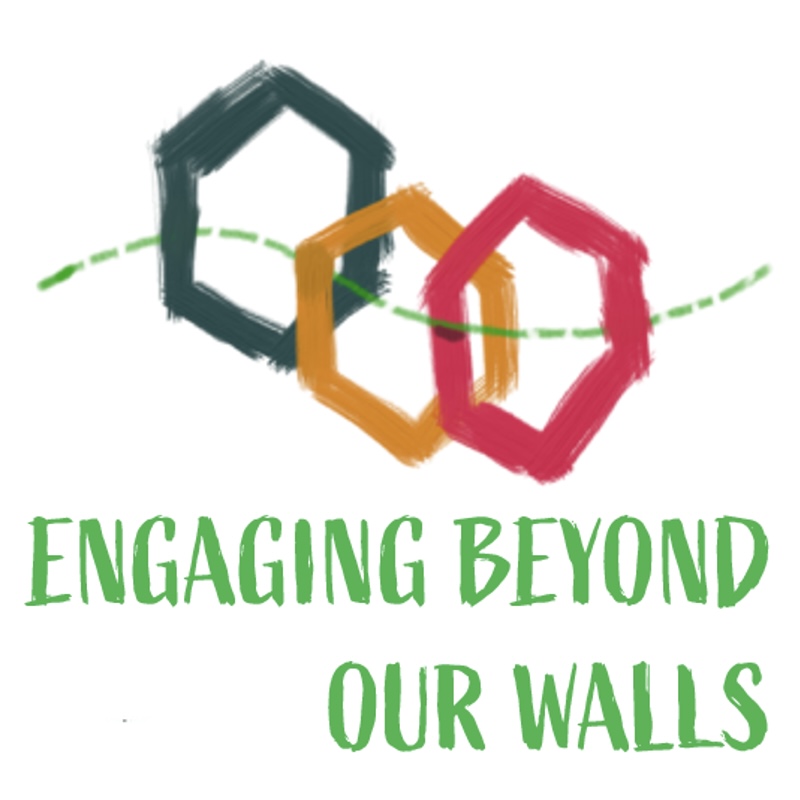Local games and interactive stories to Engage Beyond Our Walls
A low-tech approach for libraries and their communities
 Libraries are creating their own outdoor games and interactive stories featuring local history, landmarks, and voices. These playful activities, often made by library staff, include texting with a mural, an audio tour by a Black feminist historian, a ghost scavenger hunt, and an “I spy” quest for architecture and culture. The creations are proudly low-tech. The larger approach is part of the national project, Engaging Beyond Our Walls (EBOW), and reveals new ways for libraries to connect with their community.
Libraries are creating their own outdoor games and interactive stories featuring local history, landmarks, and voices. These playful activities, often made by library staff, include texting with a mural, an audio tour by a Black feminist historian, a ghost scavenger hunt, and an “I spy” quest for architecture and culture. The creations are proudly low-tech. The larger approach is part of the national project, Engaging Beyond Our Walls (EBOW), and reveals new ways for libraries to connect with their community.
So far, more than 50 towns and cities have jumped in to create experiences, often with free templates and training from the Playful City Lab of American University and the DC Public Library. The do-it-yourself tools were initially funded by a grant from IMLS, based on earlier pilots with the Smithsonian. The Lab’s goal is to democratize design so that libraries and neighborhoods of all sizes can tell their own stories, and ultimately build stronger places.

Tasting menu: something for everyone
Sometimes you want just a nibble; other times, you’re ready for a main course. There is something for everyone when it comes to engaging beyond our walls, and simpler ideas and projects can also lead to real outcomes that catalyze community.
A starter size: These projects can be designed with a few sticky notes, some inspiration, and a dash of playfulness. For example, a small library in Milton, Wisconsin brought to life a sculpture just outside the building that features three metal birds in a garden. They created “text with the birds,” which allowed people to send a text message to the birds to learn more. Each bird had a different personality and replied to texts with information about a different aspect of community life. One bird told jokes written by local youth; another revealed some of the history of the library; and all three were featured on t-shirts the library sold to raise funds. The only physical material needed for the project was a printed sign to provide instructions for the texting adventure.
The texting technology can either be through a free service like Google Voice, custom tools for libraries like Hive Mechanic (from the Playful City Lab), or commercial tools like Twilio Studio. Getting started with a similar project can be accomplished quickly. The outline of a design can be done in an afternoon, from brainstorming the dialog, to writing the basic script in a Google Doc, to testing out a few text messages using your own phone.

A bigger bite: Audio tours, history scavenger hunts, and cell phone photography quests can all be easier than you might think. But, they also take a bit more iteration and development to get the tone and pacing right. For one example, the DC Public Library collaborated with the National Women’s History Museum to create a “community voice over” for an exhibit in the library. The primary exhibit already had rich content, but the library wanted to engage a wider audience, and use the voice of a famous resident to drive the experience. Read and listen to a description of the project on the Playful City Lab blog.
A specialty platter: Projects that are a heavier lift or with special features include stories that respond to the physical world, like climate stories that vary depending on today’s weather, stories that change when a local bus is late, projects that involve motion sensors or turning on outdoor lights, and stories that use tools like ChatGPT to modify a story in real-time.
Accessibility is a key part of all the projects above. All are proudly low-tech and are possible with ordinary text messaging, voice trees, and multimedia messaging with basic cell phones, with no fancy apps or data plans required for patrons. Just as importantly, most library staff can write the stories and content.
Learn more: Dive into this Tasting Menu of 13 different projects with "recipes" and ideas to help you get started.
Coming soon: Detailed templates for impact
Later this year, additional resources and tools will be available for free and will be shared through WebJunction.
- Free and low-cost technologies and services - a survey report
- Impact stories - some of the outcomes that have been documented, including expanding reach, empowering the library as a “community catalyst” that brings partners together, history education, breaking local stereotypes and myths, empowering youth as co-designers, and bringing joy to the community.
More background is also available about the project in this 2021 press release, and in an earlier list of sample projects that used the Hive Mechanic tool. Inspiration and ideas are waiting for you and your community to explore!
Webinar recording
Engaging Beyond Our Walls
Discover how libraries can use outdoor games and interactive stories to connect with communities and showcase local history and landmarks.
Thursday, September 26, 2024
